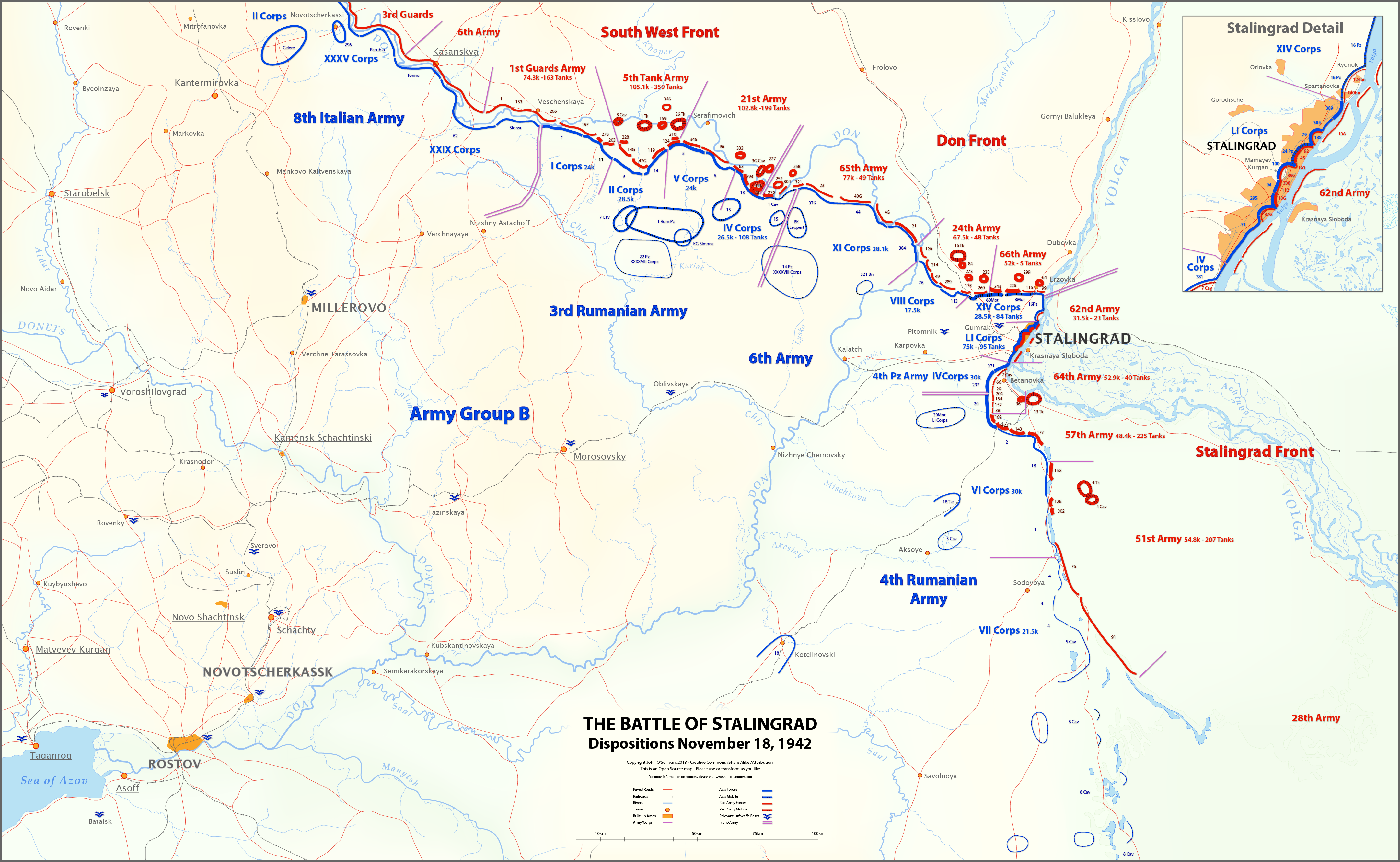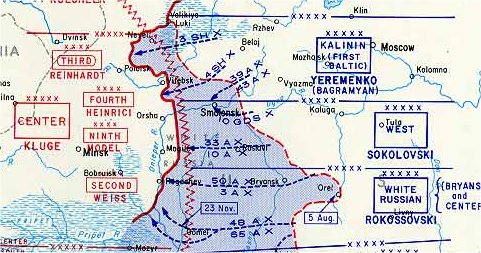|
Alexey Rodin (general)
Alexey Grigoryevich Rodin (Russian: Алексей Григорьевич Родин; 17 February 1902 – 27 May 1955) was a Soviet Army colonel general and Hero of the Soviet Union. Born to a peasant family, Rodin was drafted into the Red Army in 1920. After fighting in the Russian Civil War, he became an officer and rose to command 50th Rifle Corps Armored and Mechanized forces during the Winter War. After the end of the war, Rodin became deputy commander of the 24th Tank Division and fought in the Baltic Operation and Leningrad Strategic Defensive. Given command of the 124th Tank Brigade in September 1941, he led the unit during battles around Leningrad and in the Lyuban Offensive Operation. From June 1942, Rodin commanded the 26th Tank Corps and led the unit during Operation Uranus. For its actions, the corps became the 1st Guards Tank Corps and Rodin received the title Hero of the Soviet Union. After Stalingrad, he was promoted to command the 2nd Tank Army and led it du ... [...More Info...] [...Related Items...] OR: [Wikipedia] [Google] [Baidu] |
Ostashkovsky District
Ostashkovsky District (russian: Оста́шковский райо́н) is an administrative and municipalLaw #4-ZO district (raion), one of the thirty-six in Tver Oblast, Russia. It is located in the northwest of the oblast and borders with Demyansky District of Novgorod Oblast in the north, Firovsky District in the northwest, Kuvshinovsky District in the east, Selizharovsky District in the south, Penovsky District in the southwest, and with Maryovsky District of Novgorod Oblast in the west. The area of the district is . Its administrative center is the town of Ostashkov. Population: 23,761 ( 2010 Census); The population of Ostashkov accounts for 76.1% of the district's total population. Geography The major part of the district belongs to the drainage basin of the Volga River. The source of the Volga is located in the district, in the selo of Volgoverkhovye. The district is locates in the southern outskirts of the Valdai Hills, and there is a large lake district in the area ... [...More Info...] [...Related Items...] OR: [Wikipedia] [Google] [Baidu] |
Lyuban Offensive Operation
The Battle of Lyuban, Lyuban offensive operation or Battle of the Volkhov (7 January 1942 – 30 April 1942) (Russian: Любанская наступательная операция; German: Schlacht am Wolchow) was a Soviet offensive operation of World War II. It was conducted by the Volkhov and Leningrad Fronts of the Red Army with the goal of relieving the siege of Leningrad and encircling and destroying the German forces carrying out the siege. The offensive used no tanks because of the terrain, therefore it was down to the infantry and the artillery. The attacking Soviet forces found themselves under intense fire from German defensive positions, and the Red Army lacked proper artillery support against the German lines. The offensive stalled and the Soviets went over to the defensive. Field Marshal Georg von Küchler counterattacked with an operation called 'Wild Beast" (''Operation Raubtier'') and the Soviet 2nd Shock Army was cut off and surrounded. It was destroyed in Ju ... [...More Info...] [...Related Items...] OR: [Wikipedia] [Google] [Baidu] |
Western Front (Soviet Union)
The Western Front was a front of the Red Army, one of the Red Army Fronts during World War II. The Western Front was created on 22 June 1941 from the Western Special Military District (which before July 1940 was known as Belorussian Special Military District). The first Front Commander was Dmitry Pavlov (continuing from his position as District Commander since June 1940). The western boundary of the Front in June 1941 was long, from the southern border of Lithuania to the Pripyat River and the town of Włodawa. It connected with the adjacent North-Western Front, which extended from the Lithuanian border to the Baltic Sea, and the Southwestern Front in Ukraine. Operational history Front dispositions 22 June 1941 The 1939 partition of Poland according to the Molotov–Ribbentrop Pact established a new western border with no permanent defense installations, and the army deployment within the Front created weak flanks. At the outbreak of war with Germany, the Western Special ... [...More Info...] [...Related Items...] OR: [Wikipedia] [Google] [Baidu] |
Operation Uranus
Operation Uranus (russian: Опера́ция «Ура́н», Operatsiya "Uran") was the codename of the Soviet Red Army's 19–23 November 1942 strategic operation on the Eastern Front of World War II which led to the encirclement of Axis forces in the vicinity of Stalingrad: the German Sixth Army, the Third and Fourth Romanian armies, and portions of the German Fourth Panzer Army. The Red Army carried out the operation at roughly the midpoint of the five-month long Battle of Stalingrad, aiming to destroy German forces in and around Stalingrad. Planning for Operation Uranus had commenced in September 1942, and developed simultaneously with plans to envelop and destroy German Army Group Center (Operation Mars) and German forces in the Caucasus. Due to the length of the front lines created by the German 1942 summer offensive, which had aimed at taking the Caucasus oil fields and the city of Stalingrad, German and other Axis forces were over-extended. The German ... [...More Info...] [...Related Items...] OR: [Wikipedia] [Google] [Baidu] |
24th Tank Division
The 24th Tank Division was a tank division of the Soviet Union, formed twice. The division's first formation was formed in the spring of 1941 and fought in the Leningrad Strategic Defensive before being broken up into two smaller brigades. The division's second formation was originally formed in 1956 as the 24th Heavy Tank Division and became a regular tank division in 1957. It became a training division in 1960 and was redesignated the 54th District Training Center in 1987 before being disbanded in 1995. History First formation Formation of the division began in March 1941. It was part of the 10th Mechanized Corps. It was based in Pushkin and Slutsk. The division was formed from the 2nd Light Tank Brigade. 2nd Light Tank Brigade commander Alexey Rodin became its acting commander. In late May, Colonel M.I. Chesnokov took command of the division. When Operation Barbarossa began on 22 June 1941, the division was ordered to combat readiness. 13 tanks from the 49th Tank Regi ... [...More Info...] [...Related Items...] OR: [Wikipedia] [Google] [Baidu] |
50th Rifle Corps
The 50th Rifle Corps was a corps of the Soviet Red Army. It was part of the 23rd Army on 22 June 1941. It took part in the Great Patriotic War. Organization On 22 June 1941, the corps included the following units: * 43rd Rifle Division * 70th Rifle Division * 123rd Rifle Division Commanders * Komkor Filipp Gorelenko (08.1939 - 05.1940) * Komkor Panteleimon Zaitsev (05.1940 - 08.1940) * Major General Vladimir Shcherbakov (17.01.1941 - 04.08.1941) * Major General Sarkis Martirosyan (25.06.1943 - 24.04.1944) * Major General Pavel Batitsky Pavel Fyodorovich Batitsky ( ua, Павло Федорович Батицький; russian: Па́вел Фёдорович Бати́цкий; 27 June 1910 – 17 February 1984) was a Soviet military leader awarded the highest honorary title of ... (25.04.1944 - 27.05.1944) * Major General Serafim Merkulov (28.05.1944 - 20.04.1945) * Major General Nikolai Tavartkiladze (21.04.1945 - 11.05.1945) References Citations Bibliog ... [...More Info...] [...Related Items...] OR: [Wikipedia] [Google] [Baidu] |
Colonel General
Colonel general is a three- or four-star military rank used in some armies. It is particularly associated with Germany, where historically general officer ranks were one grade lower than in the Commonwealth and the United States, and was a rank above full , but below . The rank of colonel general also exists in the armed forces organized along the lines of the Soviet model, where it is comparable to that of a lieutenant general in many NATO armed forces (rank code OF-8). The rank of colonel general that exists within the Arab model () corresponds to a full general (NATO rank code OF-9). Austria Colonel general () was the second-highest rank in the Austro-Hungarian Army, introduced following the German model in 1915. The rank was not used after World War I in the Austrian Army of the Republic. Czechoslovakia The rank of colonel general () was created in the Czechoslovak army in 1950; it was dropped after the 1993 dissolution of the state. Egypt The Egyptian Army uses a r ... [...More Info...] [...Related Items...] OR: [Wikipedia] [Google] [Baidu] |
Soviet Army
uk, Радянська армія , image = File:Communist star with golden border and red rims.svg , alt = , caption = Emblem of the Soviet Army , start_date = 25 February 1946 , country = (1946–1991)' (1991–1992) , branch = , type = Army , role = Ground warfare, Land warfare , size = 3,668,075 active (1991) 4,129,506 reserve (1991) , command_structure = , garrison = , garrison_label = , nickname = "Red Army" , patron = , motto = ''За нашу Советскую Родину!(Za nashu Sovetskuyu Rodinu!)''"For our Soviet Motherland!" , colors = Red and yellow , colors_label = , march ... [...More Info...] [...Related Items...] OR: [Wikipedia] [Google] [Baidu] |
Hero Of The Soviet Union
The title Hero of the Soviet Union (russian: Герой Советского Союза, translit=Geroy Sovietskogo Soyuza) was the highest distinction in the Soviet Union, awarded together with the Order of Lenin personally or collectively for heroic feats in service to the Soviet state and society. Overview The award was established on 16 April 1934, by the Central Executive Committee of the Soviet Union. The first recipients of the title originally received only the Order of Lenin, the highest Soviet award, along with a certificate (грамота, ''gramota'') describing the heroic deed from the Presidium of the Supreme Soviet of the USSR. Because the Order of Lenin could be awarded for deeds not qualifying for the title of hero, and to distinguish heroes from other Order of Lenin holders, the Gold Star medal was introduced on 1 August 1939. Earlier heroes were retroactively eligible for these items. A hero could be awarded the title again for a subsequent heroic feat with ... [...More Info...] [...Related Items...] OR: [Wikipedia] [Google] [Baidu] |
Operation Bagration
Operation Bagration (; russian: Операция Багратио́н, Operatsiya Bagration) was the codename for the 1944 Soviet Byelorussian strategic offensive operation (russian: Белорусская наступательная операция «Багратион», Belorusskaya nastupatelnaya Operatsiya ''Bagration''), a military campaign fought between 22 June and 19 August 1944 in Soviet Byelorussia in the Eastern Front of World War II, just over two weeks after the start of Operation Overlord in the west, causing the Germans to have to fight on two major fronts at the same time. The Soviet Union destroyed 28 of 34 divisions of Army Group Centre and completely shattered the German front line. It was the biggest defeat in German military history, with around 450,000 German casualties, while 300,000 other German soldiers were cut off in the Courland Pocket. On 22 June 1944, the Red Army attacked Army Group Centre in Byelorussia, with the objective of encirclin ... [...More Info...] [...Related Items...] OR: [Wikipedia] [Google] [Baidu] |
Operation Suvorov
The second Smolensk operation (7 August – 2 October 1943) was a Soviet strategic offensive operation conducted by the Red Army as part of the Summer-Autumn Campaign of 1943. Staged almost simultaneously with the Lower Dnieper Offensive (13 August – 22 September), the offensive lasted two months and was led by General Andrei Yeremenko, commanding the Kalinin Front, and Vasily Sokolovsky, commanding the Western Front. Its goal was to clear the German presence from the Smolensk and Bryansk regions. Smolensk had been under German occupation since the first Battle of Smolensk in 1941. Despite an impressive German defense, the Red Army was able to stage several breakthroughs, liberating several major cities, including Smolensk and Roslavl. As a result of this operation, the Red Army was able to start planning for the liberation of Belarus. However, the overall advance was quite modest and slow in the face of heavy German resistance, and the operation was therefore accomplished in ... [...More Info...] [...Related Items...] OR: [Wikipedia] [Google] [Baidu] |




